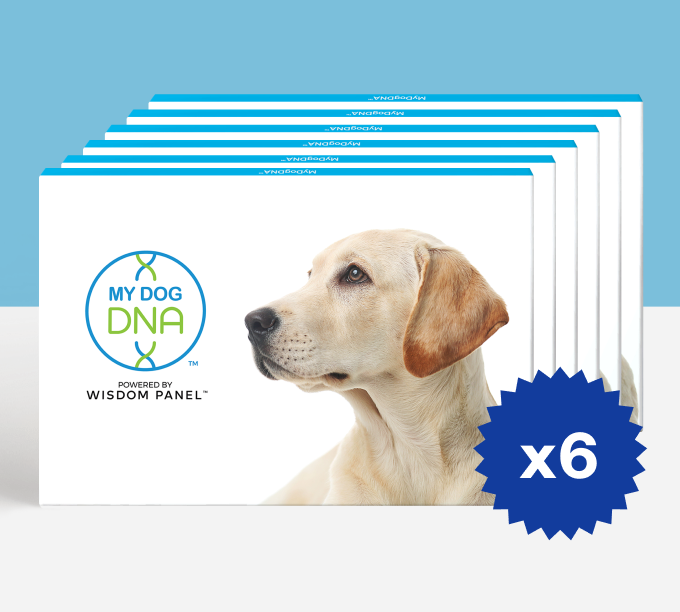What is PRA?
Various forms of Progressive Retinal Atrophy (PRA) –a group of retinal diseases that result in blindness-- are among the most highly studied forms of inherited disorders in dogs. Fortunately, and thanks to decades of dedicated research, more than 30 different genetic variants, i.e. mutations, that cause PRA have been identified. DNA tests for most of these genetic variants are now available to dog breeders and use of these tools has dramatically decreased the incidence PRA-related blindness in a wide variety of dog breeds.
PRA mutations cause blindness by altering specific steps along the intricate pathway that our dogs’ eyes rely on as light is transformed into an electrical signal and transmitted to our brains allowing us to “see”. This light transformation occurs in two types of photoreceptors called rods and cones in the retina at the back of the eye. It is in these photoreceptors that most of the PRA-causing mutations cause problems. Rod cells are what enable vision in low light conditions while cones are responsible for visual acuity in bright light and provide us with our ability to see colors. In dogs, rod cells are far more abundant than cone cells.
As the name suggests, PRA is marked by the progressive atrophy (or degeneration) of the retina. Most of the PRA mutations we have identified so far have been shown to first cause the death of either rod or cone photoreceptors and then subsequently the death (or atrophy) of other surrounding retinal cells. The name of the specific PRA is often an indicator of which retinal cells are first targeted. For example, progressive rod-cone degeneration (prcd-PRA), the most widespread cause of PRA across all dog breeds with a frequency of 1.6% in purebred dogs, 3.3% in mixed-breed dogs, and found in over 50 breeds is characterised by the initial degeneration of rod cells followed by the death of cone cells.

What is CORD-1 PRA?
Cord1-PRA is known by many names, including crd4, RPGRIP1-CRD, and cord1. Unlike prcd-PRA discussed above, Cone Rod Dystrophy-1 (cord1-PRA) is so named because the first clinical sign of retinal disease occurs in the cone cells; this is followed by rod cell degeneration. Also, in contrast to other forms of PRA, cord-1 has proven to be a highly variable form of PRA in which presence of the variant has not been as predictive of clinical disease when compared to other variants. Multiple research groups have focused on what is responsible for such variability and although not complete, our understanding of the inheritance of this disorder has greatly improved over the years. As the scientific story behind cord1-PRA has unfolded, Wisdom Panel™ reporting of this disorder has evolved. Here is a bit of that story.
Eureka! Cord1-PRA, The First Ten Years:
In 2006 a team led by canine-genetics pioneer, Dr. Cathryn Mellersh, identified a significant genetic variation in a gene called RPGRIP1 that was associated with PRA in a colony of Miniature Long Haired Dachshunds (MLHDs). Retinitis Pigmentosa (RP) is the human equivalent of PRA in dogs, and mutations in RPGRIP1 are known to cause RP in humans, so the finding of the canine equivalent was a strong indicator of the gene’s importance in the Dachshund colony. All of the PRA-affected MLHDs in the colony carried two copies of the RPGRIP1 mutation and no other detected variants. MLHDs carrying only one copy of the RPGRIP1 mutation were not PRA-affected but when bred to other RPGRIP1-carriers produced MLHDs with two copies of the mutation, which were subsequently PRA-affected. Eureka! A DNA test that detects the RPGRIP1 mutation was soon developed and made available to help breeders prevent this early-onset form of PRA. This was great news, mystery solved! But as it turns out, there was more to the story than researchers first realised.
As more dogs, including Dachshunds and other breeds, were tested for the RPGRIP1 mutation, it became clear that not all dogs carrying two copies of the RPGRIP1 mutation developed PRA and that there was a lot of variation in disease severity and age of onset, if it did indeed occur. Although some clinical variation is not uncommon in many forms of PRA, the growing disparity between dogs with two copies of the RPGRIP1 mutation and those showing PRA signs was becoming problematic. This was especially a concern in breeds where the frequency of the RPGRIP1 mutation was high and breeders were rightfully concerned about the negative effect of removing high quality dogs from the gene pool based on the cord1-PRA test.

Cord1-PRA, from 2016-Present:
In the ten years following the 2006 discovery of the RPGRIP1 mutation in MLHDs, multiple research groups published papers that showed a strong likelihood that other genetic factors likely modify the impact of the RPGRIP1 mutation and it was questioned whether RPGRIP1 was even the primary cause of cord1-PRA-associated disease. One of these genetic factors was shown by Miyadera et al. in 2012 to be within the workings of the RPGRIP1 gene itself, while also noting that additional, as yet unidentified, gene(s) were likely involved in cord1-PRA expression.
In 2016, Dr. Oliver Forman and other members of the Mellersh team, published another important breakthrough on this disease. They had found a mutation in a 2nd gene called MAP9 that explained a great deal of the variation observed with cord1-PRA. Two copies of the MAP9 variant, in combination with two copies of the RPGRIP1 variant were shown to correlate quite well with development of severe and early onset cord1-PRA, usually under three years of age in Dachshunds. When dogs that are free of the MAP9 mutation but carry two copies of the RPGRIP1 mutation, cord1 PRA is less severe and occurs often after 6 years of age if at all.
Wisdom Panel™ geneticist Dr. Jonas Donner teamed up with Dr. Mellersh to show distribution of both RPGRIP1 and MAP9 in over 130 purebred breeds, showing that only a small fraction of breeds carry both variants with moderate to high frequency. Not surprisingly, the breed type with the highest frequency of both variants is the Miniature Longhaired Dachshund, but some surprising breeds also showed the presence of the necessary two variants, including French Bulldogs, Beagles, Chihuahuas, Beagles, and Rottweilers. The figures above and below summarise this work.

In addition to the above two variants, it appears likely that at least one more genetic factor is at work. As described in 2023 by Ripolles-Garcia et al., an as-yet uncharacterised genetic variant currently termed “L3”, has been shown to play an additional pivotal role in cord1-PRA. When two copies of each of all three different variants (RPGRIP1, MAP9 and L3) are present, severe and early onset cord1-PRA is extremely likely to occur.

What about genetic testing for cord1-PRA?
Unfortunately, detection of the MAP9 mutation is technically very challenging and at this point, there are no commercially available DNA tests for it. Also, the L3 variant has yet to be identified, so no commercially available tests have yet been developed for it either. Because the RPGRIP1 mutation has been conclusively shown to be an integral factor in the development of cord1-PRA, and its prevalence is significant along with MAP9 in a number of breeds, Wisdom Panel™ reinstated reporting of this variant in 2023 for all breeds in MyDogDNA™ and Optimal Selection™ Canine .
In the future, Wisdom hopes to develop testing for MAP9 and L3 (once discovered) variants to provide a combined risk score with RPGRIP1 for cord1-PRA. At this time, RPGRIP1 results are available so that breeders can take it into consideration when breeding, understanding that the variant is only one piece of the cord1-PRA risk puzzle.








